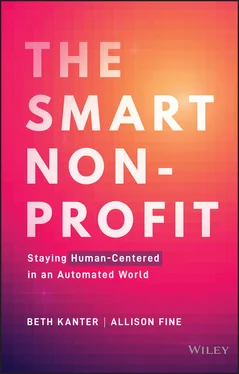You may be waiting for some bad guy to emerge in this story: a company gathering data to sell to pharmaceutical companies or a government agency intentionally blocking access to services. There will be stories like that later in this book, but this isn't one of them.
All the actors here had good intentions. HUD wanted to ease access into the homeless system by using multiple access points and placing local organizations in charge of the assessment. OrgCode was trying to create a standard tool for social workers and disseminate it easily, freely, and quickly. Leah and her colleagues were dedicated to helping the most vulnerable people in their communities receive appropriate services quickly. And, of course, clients who were walking in off the street just wanted to be safe at least for one night.
And yet, the VI-SPDAT was so fundamentally flawed that OrgCode announced in 2021 that it would no longer recommend or support it.
We use “smart tech” as an umbrella term for advanced digital technologies that make decisions for people, instead of people. It includes artificial intelligence (AI) and its subsets and cousins such as machine learning, natural language processing, smart forms, chatbots, robots, and drones. We want to be expansive in our use and understanding of the term, for instance, by including automation technologies like the one that powered the VI-SPDAT, in order to focus on the essence of the shift in power from people to machines. We substitute the word “bot” for smart tech in many sentences in this book because, well, it's fun to say.
Smart tech is not the same as digitizing a process. For instance, direct depositing a paycheck replaces printing a check and mailing it or handing it to an employee who has to endorse it and physically deposit it in the bank. Direct deposit is efficient, but it's not automation. Automation takes the power of decision-making and turns it over to machines. Automation turns a regular car into a smart car, and an active, decision-making driver into a passenger.
Netflix is powered by smart tech. They use our individual and collective viewing to make suggestions of what you may want to watch next. The more we all watch, the more accurate are Netflix's predictions. However, there is one enormous catch: the algorithms assume we want to continue watching the kinds of shows and movies we have in the past, that our future behavior will mimic past behavior. However, this isn't actually the way most people operate. We like to explore new things, bump into new people, and allow serendipity to take its course. This difference between the way machines think and the way people behave is a theme we will explore many times throughout this book.
Smart tech has some similarities with social media but more importantly, a few fundamental differences. Both are powered by digital technology, computer code, and enormous amounts of data. They also use the data and algorithms to predict future behavior. For instance, Facebook shows you ads based on what you have liked and shared previously. The more accurate Facebook's predictions, the more likely you are to click on an ad, which is how they make their money. However, we can see how Facebook operates or at least the results of Facebook's calculations. Even if Facebook doesn't want to put much work into controlling hate speech on its platform, we can see it unfolding on the platform. And if you can find the button to click to show you the most recent feeds, you can see which posts you've missed because Facebook decided to show you something else.
While social media is visible, smart tech is invisible like air. It doesn't care if you're rich or poor, at home in your kitchen, in the park, or at the office; it is everywhere around us working all the time. It is quickly becoming embedded in organizational life and making critical decisions such as who gets services, when and how, and how staff are performing their jobs. Perhaps the biggest difference between social media and smart tech is that the former creates an enormous amount of work while the latter, if used well, can create an enormous amount of time. And that time can be used to reduce burnout of staff; increase time spent with clients, volunteers, and donors; and imagine new ways to solve difficult problems.
Smart tech is best at doing rote tasks such as filling out intake forms and answering the same questions from people (for example, “Is my contribution tax-deductible?”) over and over. However, the technology is quickly moving beyond paperwork and embedding itself into the heart of nonprofit work. This is profoundly changing what we do, why we do it, and how successful we are in meeting our missions.
Nonprofits are beginning to use smart tech to:
Screen resumes based on criteria organizations set but without those organizations likely seeing the people who were screened out.
Determine eligibility for a host of social services such as SNAP food assistance, housing, and childcare.
Identify prospective donors from your fundraising data or from the web.
Customize stories for and communications to donors based on their past behavior.
Stock food pantry shelves.
Deliver medicine and food to hard-to-reach places.
Direct refugees to available beds.
This isn't science fiction; it is real life, right now.
Automating systems isn't a technological evolution; it is a revolutionary shift in power and autonomy. Those who understand the new technology and how to use it will have more power. Those who are reporting to tech systems and are at the mercy of them are at the risk of losing their ability to determine their own futures.
Smart nonprofits understand the technology—what it can and cannot do, how to use it well, and how to avoid unintentional harmful consequences.
BECOMING A SMART NONPROFIT
Smart nonprofits use a disciplined approach to adopting smart tech carefully and strategically while always maintaining the highest ethical standards and responsible use. Smart nonprofits are:
Human-centered: A human-centered approach means finding the sweet spot between people and smart tech, while ensuring that people are always in charge of the technology. Smart nonprofits ensure that the use of smart tech always aligns with their values.
Prepared: Organizations need to take intentional preparation steps. They must actively reduce bias embedded in smart tech code and systems. They also thoroughly correct and label data to be incorporated into a smart tech system. And lastly, they must have a formal process to select systems, vendors, and consultants that align with their organization's values.
Knowledgeable and reflective: Learning about what smart tech is and does is an ongoing process in the boardroom, the C-suite, and for nonprofit staffs. Once automated systems are in place, organizations need to be vigilant about whether they are performing as hoped or unintended consequences have arisen, and how clients and end users feel about the systems. We have embedded reflection questions throughout this book to help create the habit of asking important questions over time.
Working this way with smart tech creates a gift of new time.
Staff people spend about 30% of their time on administrative tasks. Smart tech is going to automate many of these tasks, thereby freeing up staff to do other things. This newly found time creates a choice for organizations. This new time could be used to do more of the same kinds of tasks that value efficiency over effectiveness and the number of people served over the number of problems solved. Or they can use this precious gift to become something new and better. We hope organizational leaders will choose the latter. We call this return on investment for the use of smart tech the dividend of time . 6
Читать дальше












